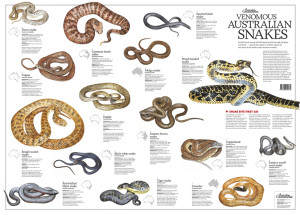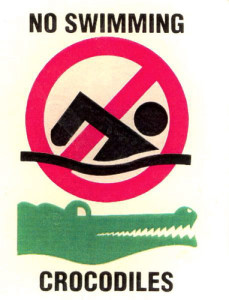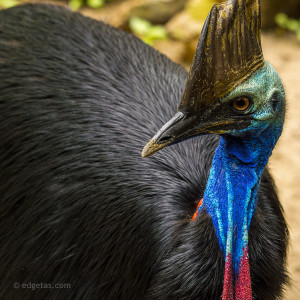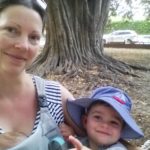Animal Encounters: Australia
- Blog Animal Encounters: Australia
Did you know Hike it Baby is in Australia? While we have bears, moose, ticks and occasionally snakes in North America, but in Australia they have their own set of things. Here's an article from our Australia branch.
Terra Australis Incognita, Australia, The Land Down Under, Oz. Whatever you call it, it has a fearsome reputation for hosting some of the world’s deadliest animals. Fortunately, contrary to popular belief, not all of them want to kill you and there are plenty of simple tips to help you steer clear of them when you are out and about. This can help you navigate the wildlife you may find around Australia.
 • Do not disturb – this means picking them up, walking over the top of them, waving your arms around in manner they perceive to the threatening, poking them with a stick, trying to corral them away from a path or cornering them. Interestingly, snakes are largely deaf so you can verbally alert others to its presence without fear of increased aggression from the snake.
• Australian snakes are timid – our snakes don’t like human company so give them the chance to flee, rather than trying to step too close to them. If you walk too close and there is no escape path, back away very slowly.
• Look where you put your feet and hands - Step onto, rather than over logs, look into hollow logs and rock crevices before putting a hand in them (or even better, look only), avoid walking through long grass or reeds
• Clothing may deflect a bite – the ankle area is the most common area for bites to occur. Wear solid shoes when bush walking, preferably with gaiters or long pants.
• Be alert at all times – snakes like to warm up in the early morning, especially during the warmer months but at this time may be slow to flee.
• Brush up on your first aid – know how to treat a snake bit and if you are regular in snake country, make sure you take appropriate first aid items with you.
• Do not disturb – this means picking them up, walking over the top of them, waving your arms around in manner they perceive to the threatening, poking them with a stick, trying to corral them away from a path or cornering them. Interestingly, snakes are largely deaf so you can verbally alert others to its presence without fear of increased aggression from the snake.
• Australian snakes are timid – our snakes don’t like human company so give them the chance to flee, rather than trying to step too close to them. If you walk too close and there is no escape path, back away very slowly.
• Look where you put your feet and hands - Step onto, rather than over logs, look into hollow logs and rock crevices before putting a hand in them (or even better, look only), avoid walking through long grass or reeds
• Clothing may deflect a bite – the ankle area is the most common area for bites to occur. Wear solid shoes when bush walking, preferably with gaiters or long pants.
• Be alert at all times – snakes like to warm up in the early morning, especially during the warmer months but at this time may be slow to flee.
• Brush up on your first aid – know how to treat a snake bit and if you are regular in snake country, make sure you take appropriate first aid items with you.
 Saltwater crocodiles – also known as Salties or crocs, have a fearsome reputation and do not tolerate invasion of their territory lightly.
Their habitat consists mostly of coastal rivers and swamps although they extend well inland via major rivers and billabongs (watering holes) in the river flood plains. The geographical distribution of these crocodiles roughly follows the coastline from Broome in WA all the way around to Gladstone in Queensland.
How to avoid interaction with a saltwater crocodile:
• Common sense – in croc country, don’t assume that it is safe to take a cooling dip, even if there is no sign on a post and stay away from the water’s edge whilst walking. This also extends to dogs as crocs are not that fussy.
• Avoid confrontation - steer clear of areas if you see signs of a croc or areas where native animals or cattle come to drink. Never approach a nest or baby crocs as the mother is always near by.
• Don’t feed the crocs - don’t gut fish near the water or discard fish or food scraps into the water.
• Extra vigilance – take extra care at dusk and night as well as during breeding season (September to May).
• Encounter – stay calm and depart the area slowly away from the water. However, if it starts snapping this means that it is aggravated and it is a good time to pick up the kids and run.
Saltwater crocodiles – also known as Salties or crocs, have a fearsome reputation and do not tolerate invasion of their territory lightly.
Their habitat consists mostly of coastal rivers and swamps although they extend well inland via major rivers and billabongs (watering holes) in the river flood plains. The geographical distribution of these crocodiles roughly follows the coastline from Broome in WA all the way around to Gladstone in Queensland.
How to avoid interaction with a saltwater crocodile:
• Common sense – in croc country, don’t assume that it is safe to take a cooling dip, even if there is no sign on a post and stay away from the water’s edge whilst walking. This also extends to dogs as crocs are not that fussy.
• Avoid confrontation - steer clear of areas if you see signs of a croc or areas where native animals or cattle come to drink. Never approach a nest or baby crocs as the mother is always near by.
• Don’t feed the crocs - don’t gut fish near the water or discard fish or food scraps into the water.
• Extra vigilance – take extra care at dusk and night as well as during breeding season (September to May).
• Encounter – stay calm and depart the area slowly away from the water. However, if it starts snapping this means that it is aggravated and it is a good time to pick up the kids and run.
 Cassawary – The cassowary is a large (as tall as a human) bird and, as I read somewhere, “has the attitude of a teenage girl when she just got dumped by her boyfriend because he didn’t want to go see the new twilight movie”. These birds are territorial and will attack (read: attempt to disembowel you with 6 inch long claws) if they feel threatened, especially if they have chicks or eggs to defend. However, like most animals, they are relatively benign if you steer clear of them. If confronted, remain calm and back away slowly. However, thankfully for most of us, their geographical distribution is limited to the northern parts of Queensland.
European Honey Bees – for approximately 97% of the population, these little critters may deliver a painful, but non lethal sting. Unfortunately for the remaining 3%, the anaphylactic reaction to the bee venom can be fatal. Technical, these bees are more deadly in Australia than our spiders because of the higher rate of interaction humans have with the bees.
Cassawary – The cassowary is a large (as tall as a human) bird and, as I read somewhere, “has the attitude of a teenage girl when she just got dumped by her boyfriend because he didn’t want to go see the new twilight movie”. These birds are territorial and will attack (read: attempt to disembowel you with 6 inch long claws) if they feel threatened, especially if they have chicks or eggs to defend. However, like most animals, they are relatively benign if you steer clear of them. If confronted, remain calm and back away slowly. However, thankfully for most of us, their geographical distribution is limited to the northern parts of Queensland.
European Honey Bees – for approximately 97% of the population, these little critters may deliver a painful, but non lethal sting. Unfortunately for the remaining 3%, the anaphylactic reaction to the bee venom can be fatal. Technical, these bees are more deadly in Australia than our spiders because of the higher rate of interaction humans have with the bees.
 Sara is the Branch Lead for Perth, Australia. Originally from the UK, Sara moved to Perth three years ago with her Australian husband. Now they have two boys under two and a very 'enthusiastic' dog. Hiking gets the whole family out of the house, exploring the gems of the region and keeps everyone entertained (and sane).
Sara is the Branch Lead for Perth, Australia. Originally from the UK, Sara moved to Perth three years ago with her Australian husband. Now they have two boys under two and a very 'enthusiastic' dog. Hiking gets the whole family out of the house, exploring the gems of the region and keeps everyone entertained (and sane).
Do you have animals in your part of the world that should be avoided while hiking? Send us your tips and stories and we may share them in an upcoming blog! [email protected]
Snakes
More than half of all Australian snake species are poisonous so, unless you are an expert in local herpetology, it is best assume that all of them are. However, to state the obvious, snakes are only poisonous if they bite you. Here are some tips to avoid being bitten: • Do not disturb – this means picking them up, walking over the top of them, waving your arms around in manner they perceive to the threatening, poking them with a stick, trying to corral them away from a path or cornering them. Interestingly, snakes are largely deaf so you can verbally alert others to its presence without fear of increased aggression from the snake.
• Australian snakes are timid – our snakes don’t like human company so give them the chance to flee, rather than trying to step too close to them. If you walk too close and there is no escape path, back away very slowly.
• Look where you put your feet and hands - Step onto, rather than over logs, look into hollow logs and rock crevices before putting a hand in them (or even better, look only), avoid walking through long grass or reeds
• Clothing may deflect a bite – the ankle area is the most common area for bites to occur. Wear solid shoes when bush walking, preferably with gaiters or long pants.
• Be alert at all times – snakes like to warm up in the early morning, especially during the warmer months but at this time may be slow to flee.
• Brush up on your first aid – know how to treat a snake bit and if you are regular in snake country, make sure you take appropriate first aid items with you.
• Do not disturb – this means picking them up, walking over the top of them, waving your arms around in manner they perceive to the threatening, poking them with a stick, trying to corral them away from a path or cornering them. Interestingly, snakes are largely deaf so you can verbally alert others to its presence without fear of increased aggression from the snake.
• Australian snakes are timid – our snakes don’t like human company so give them the chance to flee, rather than trying to step too close to them. If you walk too close and there is no escape path, back away very slowly.
• Look where you put your feet and hands - Step onto, rather than over logs, look into hollow logs and rock crevices before putting a hand in them (or even better, look only), avoid walking through long grass or reeds
• Clothing may deflect a bite – the ankle area is the most common area for bites to occur. Wear solid shoes when bush walking, preferably with gaiters or long pants.
• Be alert at all times – snakes like to warm up in the early morning, especially during the warmer months but at this time may be slow to flee.
• Brush up on your first aid – know how to treat a snake bit and if you are regular in snake country, make sure you take appropriate first aid items with you.
Spiders
Whilst some spider venom can cause painful and disfiguring effects, there are only two spiders in Australia which have been known to have caused death – the funnel web and the Redback. However, there have been no recorded deaths from to spider bites since 1979 due to the introduction of successful anti-venoms. Unfortunately, spiders can be found all over Australia, although there are hot spots for certain species. For example, Redbacks hot spots in Perth, Brisbane and Alice Spings have higher numbers than elsewhere in the country and the funnel web group of spiders are almost solely restricted to the New South Wales. How to avoid spider bites • Wear sturdy, close toed shoes to hike in • Check your shoes and clothing before putting them on, especially if kept outside • Don’t put your hands anywhere you haven’t looked first (including your shoes). • Watch out for webs across trails • Brush up on your first aid and know how to treat a spider bite.Ticks
Ticks themselves are not dangerous but some of them carry diseases, including but not limited to the following: a number of different types of Typhus and Spotted Fevers, as well as Lyme disease. Whilst each species of tick has an individual geographical distribution, it can be assumed that ticks exist in most areas of Australia excepting the centre. The transmission of these diseases relies on the tick biting you. Here are some tips to avoid being bitten by a tick: • Repel the bugs - Use insect repellent with DEET or permethrin • Know the tick prone habitats – ticks tend to congregate in shady, humid areas such as leaf piles and grass trees, especially when kangaroos or rodents have been in the area. Try walking in the centre of trails to avoid brushing vegetation which ticks may be sitting on. • Cover up – this can prevent ticks from latching onto bare skin. Additionally ticks are dark in colour so wearing light coloured clothing can make them easier to find. • Be vigilant - Regularly check for ticks on the outside of clothing and remove them, including before you get into the car/home. Perform a full tick check on the family (dogs included) once you get home. Ticks like warm places with a good blood supply such as under the arms, in and around the ears, inside the belly button, between the legs and on the back of the knees. If you have tick infested clothing, throw it in the dryer or leave in the sun for a while as this will kill the ticks (unlike washing, which they have been known to survive!). • Remove the tick – there are lots of different opinions on how best to remove a tick but one thing remains the same: the sooner you remove a tick, the less likely you are to contract any diseases it may carry. • Keep a record – being bitten by a tick does not require immediate medical intervention. Keep a record of when/where it happened and preferably a photo of the bite or any rashes that appear. If in doubt about your health, including after the appearance of rashes or flu like, go and see your doctor.Mosquitos
The mosquito has long been touted as the most deadly animal in the world. Mosquitos occur in most places around Australia but only some carry diseases such as dengue fever and ross river virus. There are areas of higher incidence of transmittal of mosquito borne diseases so it is best to check out what may occur in your local region. Due to differing climates through Australia, different areas will have also different peak mosquito ‘seasons’. The easiest way to avoid contracting a mosquito borne disease is to avoid being bitten: • Cover up – long sleeves and pants, where bearable • Use of mosquito repellent • Avoid hiking at dawn and dusk and around wetlands or bodies of fresh water • Increase application of preventative measures during peak mosquito ‘season’Other things that you may want to avoid in Australia:
 Saltwater crocodiles – also known as Salties or crocs, have a fearsome reputation and do not tolerate invasion of their territory lightly.
Their habitat consists mostly of coastal rivers and swamps although they extend well inland via major rivers and billabongs (watering holes) in the river flood plains. The geographical distribution of these crocodiles roughly follows the coastline from Broome in WA all the way around to Gladstone in Queensland.
How to avoid interaction with a saltwater crocodile:
• Common sense – in croc country, don’t assume that it is safe to take a cooling dip, even if there is no sign on a post and stay away from the water’s edge whilst walking. This also extends to dogs as crocs are not that fussy.
• Avoid confrontation - steer clear of areas if you see signs of a croc or areas where native animals or cattle come to drink. Never approach a nest or baby crocs as the mother is always near by.
• Don’t feed the crocs - don’t gut fish near the water or discard fish or food scraps into the water.
• Extra vigilance – take extra care at dusk and night as well as during breeding season (September to May).
• Encounter – stay calm and depart the area slowly away from the water. However, if it starts snapping this means that it is aggravated and it is a good time to pick up the kids and run.
Saltwater crocodiles – also known as Salties or crocs, have a fearsome reputation and do not tolerate invasion of their territory lightly.
Their habitat consists mostly of coastal rivers and swamps although they extend well inland via major rivers and billabongs (watering holes) in the river flood plains. The geographical distribution of these crocodiles roughly follows the coastline from Broome in WA all the way around to Gladstone in Queensland.
How to avoid interaction with a saltwater crocodile:
• Common sense – in croc country, don’t assume that it is safe to take a cooling dip, even if there is no sign on a post and stay away from the water’s edge whilst walking. This also extends to dogs as crocs are not that fussy.
• Avoid confrontation - steer clear of areas if you see signs of a croc or areas where native animals or cattle come to drink. Never approach a nest or baby crocs as the mother is always near by.
• Don’t feed the crocs - don’t gut fish near the water or discard fish or food scraps into the water.
• Extra vigilance – take extra care at dusk and night as well as during breeding season (September to May).
• Encounter – stay calm and depart the area slowly away from the water. However, if it starts snapping this means that it is aggravated and it is a good time to pick up the kids and run.
 Cassawary – The cassowary is a large (as tall as a human) bird and, as I read somewhere, “has the attitude of a teenage girl when she just got dumped by her boyfriend because he didn’t want to go see the new twilight movie”. These birds are territorial and will attack (read: attempt to disembowel you with 6 inch long claws) if they feel threatened, especially if they have chicks or eggs to defend. However, like most animals, they are relatively benign if you steer clear of them. If confronted, remain calm and back away slowly. However, thankfully for most of us, their geographical distribution is limited to the northern parts of Queensland.
European Honey Bees – for approximately 97% of the population, these little critters may deliver a painful, but non lethal sting. Unfortunately for the remaining 3%, the anaphylactic reaction to the bee venom can be fatal. Technical, these bees are more deadly in Australia than our spiders because of the higher rate of interaction humans have with the bees.
Cassawary – The cassowary is a large (as tall as a human) bird and, as I read somewhere, “has the attitude of a teenage girl when she just got dumped by her boyfriend because he didn’t want to go see the new twilight movie”. These birds are territorial and will attack (read: attempt to disembowel you with 6 inch long claws) if they feel threatened, especially if they have chicks or eggs to defend. However, like most animals, they are relatively benign if you steer clear of them. If confronted, remain calm and back away slowly. However, thankfully for most of us, their geographical distribution is limited to the northern parts of Queensland.
European Honey Bees – for approximately 97% of the population, these little critters may deliver a painful, but non lethal sting. Unfortunately for the remaining 3%, the anaphylactic reaction to the bee venom can be fatal. Technical, these bees are more deadly in Australia than our spiders because of the higher rate of interaction humans have with the bees.
 Sara is the Branch Lead for Perth, Australia. Originally from the UK, Sara moved to Perth three years ago with her Australian husband. Now they have two boys under two and a very 'enthusiastic' dog. Hiking gets the whole family out of the house, exploring the gems of the region and keeps everyone entertained (and sane).
Sara is the Branch Lead for Perth, Australia. Originally from the UK, Sara moved to Perth three years ago with her Australian husband. Now they have two boys under two and a very 'enthusiastic' dog. Hiking gets the whole family out of the house, exploring the gems of the region and keeps everyone entertained (and sane).
Do you have animals in your part of the world that should be avoided while hiking? Send us your tips and stories and we may share them in an upcoming blog! [email protected]
Related Content




Comments